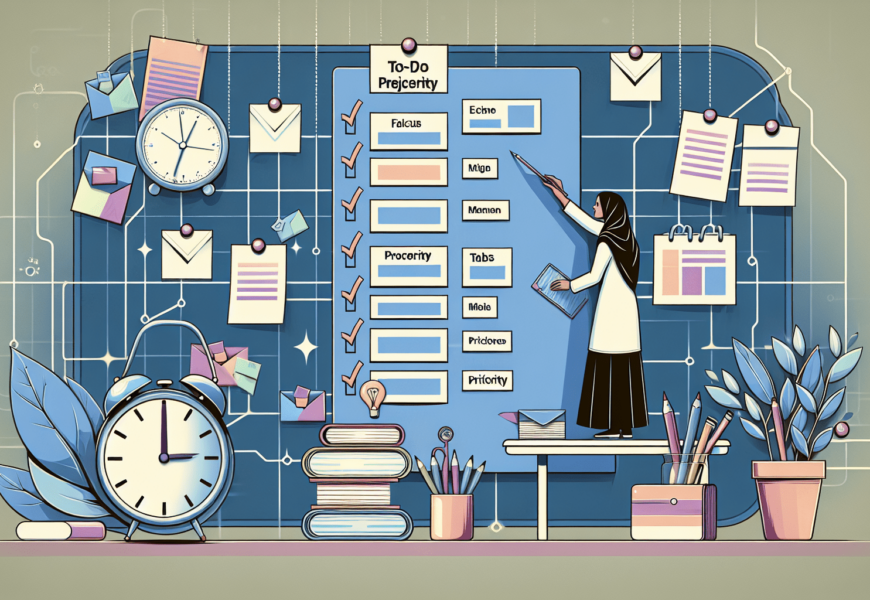Prioritizing tasks can sometimes feel overwhelming, but it doesn’t have to be. In this article, you will discover practical tips and strategies on how to effectively prioritize your tasks. Whether you’re a busy professional or a student juggling multiple responsibilities, these insights will help you stay organized and focused on what truly matters. Say goodbye to stress and hello to productivity as you learn the art of efficient task management. Ready to take charge of your to-do list? Let’s dive in!
Understanding the Importance of Task Prioritization
Task prioritization is a key skill that can significantly enhance your productivity and overall success. By effectively prioritizing tasks, you can ensure that you are focusing your time and energy on the most important and urgent activities. This can lead to greater efficiency, better time management, and a greater sense of accomplishment. On the other hand, poor task prioritization can result in missed deadlines, increased stress, and a feeling of being overwhelmed. Therefore, understanding the importance of task prioritization is essential for maximizing your productivity.
Recognizing the Benefits of Effective Task Prioritization
When you prioritize tasks effectively, you are able to make better use of your time and resources. By identifying and tackling the most important and urgent tasks first, you can avoid getting caught up in less significant activities that may not contribute to your overall goals. This allows you to focus your efforts on tasks that have the greatest impact and value, leading to increased productivity and efficiency.
Effective task prioritization also helps you stay organized and avoid feeling overwhelmed. By categorizing and ranking tasks based on their importance and urgency, you can create a clear roadmap for your daily or weekly activities. This not only reduces stress but also provides a sense of direction and control over your workload.
Furthermore, prioritizing tasks allows you to allocate your resources wisely. By identifying tasks that require more time, effort, or specialized skills, you can ensure that you have the necessary resources available to complete them successfully. This helps prevent burnout and ensures that you are working within your limitations, which is crucial for maintaining productivity and well-being.
Understanding the Consequences of Poor Task Prioritization
On the other hand, poor task prioritization can have detrimental effects on your productivity and overall success. When tasks are not prioritized effectively, you may find yourself spending valuable time and energy on less important or non-essential activities. This can lead to missed deadlines, unfinished projects, and a feeling of being overwhelmed by an ever-growing to-do list.
In addition, poor task prioritization can result in increased stress and reduced overall performance. When important tasks are constantly pushed aside or overlooked in favor of less significant ones, you may find yourself constantly playing catch-up and struggling to meet deadlines. This can lead to increased stress levels, decreased motivation, and a decrease in the quality of your work.
Another consequence of poor task prioritization is the potential for important opportunities to be missed. When tasks are not effectively prioritized, you may overlook important deadlines or fail to take advantage of time-sensitive opportunities. This can have a negative impact on your career or personal goals and prevent you from achieving the success you desire.
Overall, understanding the consequences of poor task prioritization emphasizes the importance of developing and implementing effective prioritization strategies. By prioritizing tasks effectively, you can avoid these negative outcomes and instead optimize your productivity, reduce stress, and achieve your goals more efficiently.
Setting Clear Goals and Objectives
In order to prioritize tasks effectively, it is crucial to start by setting clear goals and objectives. Clearly defining what you want to achieve in the short-term and long-term allows you to align your tasks with your overarching objectives, ensuring that you are working towards meaningful outcomes.
Defining Your Short-Term and Long-Term Goals
Short-term goals are typically those that you aim to accomplish within a relatively short time frame, such as a week or a month. These goals are important for providing immediate direction and focus for your tasks. Examples of short-term goals could be completing a project, meeting a deadline, or achieving specific targets.
Long-term goals, on the other hand, are those that you aspire to achieve over a longer period, such as six months, a year, or even several years. Long-term goals are crucial for providing a sense of purpose and motivation, as they represent the larger vision or outcome you are working towards. Examples of long-term goals could be advancing in your career, starting your own business, or pursuing further education.
Breaking Down Goals into Manageable Tasks
Once you have defined your short-term and long-term goals, the next step is to break them down into smaller, manageable tasks. Breaking down goals into tasks allows you to create a clear action plan and make progress towards your desired outcomes. It also prevents tasks from becoming overwhelming and helps ensure that they are achievable within the given timeframe.
To break down goals into manageable tasks, start by identifying the specific actions or steps required to achieve each goal. Then, organize these actions in a logical sequence or order of priority. This will provide you with a roadmap of the tasks that need to be completed in order to achieve your goals. By breaking goals down into manageable tasks, you can make progress step by step, building momentum and increasing your chances of success.
Setting clear goals and breaking them down into tasks is a fundamental step in effective task prioritization. It provides clarity and focus, allowing you to align your tasks with your objectives and work towards achieving meaningful outcomes.
Identifying Urgency and Importance
After setting clear goals and breaking them down into tasks, the next step in effective task prioritization is to identify the urgency and importance of each task. Understanding the difference between urgent and important tasks is crucial for determining which tasks should be prioritized.
Distinguishing Between Urgent and Important Tasks
Urgent tasks are those that require immediate attention and action. They have impending deadlines or time-sensitive elements that make them a priority. Urgent tasks often have direct consequences if not addressed promptly, such as missed opportunities, penalties, or negative impacts on other tasks or projects.
On the other hand, important tasks are those that have a significant impact on your overall goals and objectives. They contribute directly to your desired outcomes and are crucial for long-term success. Important tasks may not have immediate deadlines but are still essential for achieving your desired results.
Understanding the difference between urgent and important tasks is important because it helps you prioritize your activities based on their relative importance and deadlines. By distinguishing between urgent and important tasks, you can ensure that you are addressing both immediate needs and long-term goals, leading to a more balanced and effective approach to task prioritization.
Considering Deadlines and Potential Impacts
In addition to distinguishing between urgent and important tasks, it is crucial to consider the deadlines and potential impacts of each task. Deadlines provide a sense of urgency and can help determine which tasks need to be prioritized in order to meet specific time constraints. By prioritizing tasks with closer deadlines, you can ensure that you are allocating your time and resources effectively.
Potential impacts refer to the consequences or benefits that may arise from completing or neglecting specific tasks. Considering the potential impacts of each task helps you evaluate the relative importance and prioritize accordingly. For example, completing a task that has a high potential impact on your overall goals may take precedence over a task with lower potential impact, even if the latter has a closer deadline.
By recognizing the urgency and importance of tasks, considering their deadlines and potential impacts, you can make informed decisions about which tasks to prioritize and allocate your time and resources accordingly.
Categorizing Tasks
Categorizing tasks is a helpful strategy for organizing and prioritizing your workload. By creating categories based on task nature or project phases, you can group similar tasks together and allocate time and resources more effectively.
Creating Categories Based on Task Nature or Project Phases
One way to categorize tasks is based on their nature or the type of work involved. For example, you could have categories such as administrative tasks, creative tasks, research tasks, or client-related tasks. This allows you to allocate dedicated time slots for each category and ensure that all types of work are addressed.
Another approach is to categorize tasks based on the different phases of a project or workflow. For example, you could have categories such as planning, execution, review, or follow-up. This helps you stay organized and ensures that each phase of a project receives appropriate attention and priority.
By categorizing tasks based on nature or project phases, you can visually see the different types of work involved and allocate time and resources accordingly. This prevents tasks from being overlooked or neglected and allows for a more balanced approach to task prioritization.
Assigning Priority Levels to Each Category
Once you have created categories for your tasks, the next step is to assign priority levels to each category. This helps you further refine your task prioritization and ensures that you are focusing your efforts on the most important and urgent activities within each category.
Assigning priority levels can be done by using a numbering or labeling system. For example, you could use numbers from 1 to 3, with 1 representing the highest priority and 3 representing the lowest priority. Alternatively, you could use labels such as “high,” “medium,” and “low” to indicate priority levels.
By assigning priority levels to each category, you can easily identify which tasks require immediate attention and which can be addressed at a later time. This allows you to allocate your time and resources effectively and ensure that you are making progress towards your goals and objectives.
Categorizing tasks and assigning priority levels within each category is an effective strategy for organizing and prioritizing your workload. It provides structure and clarity, allowing you to allocate your time and resources more effectively and make progress towards your goals.
Utilizing Prioritization Techniques
A variety of prioritization techniques can be used to further refine your task prioritization process. These techniques provide frameworks or systems for evaluating and ranking tasks based on their importance and urgency. Two commonly used prioritization techniques are the Eisenhower Matrix and the ABCDE method.
Using Eisenhower Matrix to Prioritize Tasks
The Eisenhower Matrix, also known as the Urgent-Important Matrix, is a powerful prioritization tool that helps you categorize tasks based on their urgency and importance. The matrix consists of four quadrants, each representing a different combination of urgency and importance:
Urgent and Important: Tasks in this quadrant are both urgent and important. They require immediate attention and should be prioritized accordingly. These tasks have high potential impact and should be addressed as soon as possible.
Important but Not Urgent: Tasks in this quadrant are important but not urgent. They have a significant impact on your goals and objectives but do not have immediate deadlines. These tasks should be scheduled and given dedicated time and attention to ensure that they are completed effectively.
Urgent but Not Important: Tasks in this quadrant are urgent but not important. They may have immediate deadlines or demand immediate attention, but they do not contribute significantly to your overall goals. These tasks should be delegated or minimized to free up time for more important activities.
Not Urgent and Not Important: Tasks in this quadrant are neither urgent nor important. They should be eliminated or minimized as they do not contribute to your goals and can distract you from more meaningful activities.
By using the Eisenhower Matrix, you can visually see the different priorities of your tasks and make informed decisions about where to allocate your time and resources. This helps you avoid getting caught up in urgent but unimportant tasks and ensures that you are focusing on activities that have the greatest impact on your goals and objectives.
Applying the ABCDE Method for Task Ranking
The ABCDE method is another prioritization technique that helps you rank tasks based on their relative importance and urgency. This method involves assigning letters to each task to indicate its priority:
A tasks are those that are the most important and have the highest impact on your goals. These tasks should be completed as soon as possible and given top priority.
B tasks are important tasks but not as urgent as A tasks. They should be addressed once the A tasks are completed and given secondary priority.
C tasks are tasks that would be nice to do but are not essential or time-sensitive. These tasks can be completed after the A and B tasks are done, but they are of lower priority.
D tasks are tasks that can be delegated to others. These tasks do not require your personal attention and can be assigned to someone else with the necessary skills and resources.
E tasks are tasks that can be eliminated or postponed indefinitely. They are not important and do not contribute significantly to your goals or objectives.
By using the ABCDE method, you can easily rank your tasks based on their importance and urgency, making it easier to prioritize and allocate your time and resources effectively. This method helps ensure that you are addressing tasks in order of their priority and focusing on activities that are most aligned with your goals and objectives.
Utilizing prioritization techniques such as the Eisenhower Matrix and the ABCDE method can enhance your task prioritization process. These techniques provide frameworks for evaluating and ranking tasks, allowing you to make informed decisions about how to allocate your time and resources more effectively.
Analyzing Time and Resource Constraints
When prioritizing tasks, it is important to consider the available time and resources for each task. Understanding the limitations and constraints you are working with allows you to adjust your task prioritization and ensure that you are maximizing your productivity and efficiency.
Assessing Available Time and Resources for Each Task
Start by evaluating the amount of time required to complete each task. This includes both the estimated duration of the task itself and any additional time needed for research, preparation, or coordination with others. By accurately assessing the time required for each task, you can avoid overcommitting and ensure that your task prioritization aligns with the available time.
Next, consider the resources needed to complete each task. This includes any materials, tools, or technology required, as well as any support or assistance from others. Assessing the resource constraints for each task helps you identify potential bottlenecks or dependencies that may impact your prioritization decisions.
By analyzing the available time and resources for each task, you can make realistic and practical decisions about how to prioritize your activities. This prevents overloading yourself and ensures that you are setting yourself up for success.
Adjusting Task Prioritization Based on Limitations
Once you have assessed the time and resource constraints for each task, it may be necessary to adjust your task prioritization accordingly. This may involve reprioritizing tasks based on resource availability or reallocating time to ensure that important tasks receive the attention they require.
Adjusting task prioritization based on limitations may also require delegating tasks to others or seeking assistance and support in order to meet deadlines or accomplish tasks with limited resources. Recognizing when to ask for help or when to delegate tasks is an important skill that can enhance your efficiency and productivity.
By considering the time and resource constraints for each task and adjusting your prioritization as needed, you can optimize your productivity and ensure that you are focusing your efforts on tasks that are feasible within your limitations.
Considering Dependencies and Interdependencies
When prioritizing tasks, it is important to consider any dependencies or interdependencies that may exist between tasks. Dependencies refer to tasks that are directly dependent on the completion of other tasks, while interdependencies refer to tasks that are interconnected and impact each other’s progress or completion.
Identifying Tasks That Are Dependent on Others
Start by identifying tasks that are dependent on the completion of other tasks. This involves understanding the sequence of activities and determining which tasks must be completed first in order for subsequent tasks to be started or completed successfully.
By recognizing task dependencies, you can prioritize tasks in the appropriate order and ensure that you are not setting yourself up for delays or obstacles. Completing tasks in the correct sequence prevents bottlenecks and allows for a smooth workflow.
Managing Interdependencies to Optimize Workflow
In addition to identifying task dependencies, it is also important to manage interdependencies between tasks. Interdependencies refer to the ways in which tasks impact each other’s progress or completion. For example, completing one task may provide necessary information or resources for another task, or the completion of one task may trigger the start or continuation of another task.
By managing interdependencies effectively, you can optimize your workflow and ensure that tasks are being completed in the most efficient and logical order. This may involve coordinating with others, communicating progress and expectations, or adjusting task prioritization based on interdependent relationships.
Considering the dependencies and interdependencies between tasks allows you to prioritize and allocate your time and resources effectively. It ensures that you are progressing smoothly and efficiently, minimizing delays and maximizing productivity.
Considering Individual Work Styles
When prioritizing tasks, it is important to take into account your personal work preferences and productivity patterns. Each individual has unique strengths, weaknesses, and preferences when it comes to working styles. Adapting task prioritization methods to suit your individual needs can significantly enhance your productivity and overall satisfaction.
Understanding Personal Work Preferences and Productivity Patterns
Start by reflecting on your personal work preferences. Are you more productive in the morning or in the afternoon? Do you prefer working on one task at a time or do you thrive in a multitasking environment? Understanding your work preferences allows you to tailor your task prioritization to suit your personal strengths and maximize your efficiency.
In addition to work preferences, consider your productivity patterns. Are there specific times of day when you tend to be more focused and productive? Are there certain types of tasks that you find more engaging and enjoyable? By understanding your productivity patterns, you can align your tasks with your natural rhythms and optimize your output.
Adapting Task Prioritization Methods to Individual Needs
Once you have identified your personal work preferences and productivity patterns, adapt task prioritization methods to suit your individual needs. For example, if you are more productive in the morning, prioritize your most important and challenging tasks during that time. If you prefer working on one task at a time, focus on completing one task before moving on to the next.
Adapting task prioritization methods to your individual needs allows you to work in a way that aligns with your strengths and preferences. It enhances your efficiency, motivation, and overall satisfaction with your work.
Using Technology Tools and Apps
In today’s digital age, there are numerous technology tools and apps available that can assist with task prioritization and management. These tools provide automated features, reminders, and organization systems that can enhance your productivity and streamline your workflow.
Exploring Task Management Apps and Software
Task management apps and software are designed to help you organize, prioritize, and track your tasks more efficiently. These tools often provide features such as task lists, due dates, reminders, and progress tracking. They can also be synced across devices, allowing you to access your tasks and updates from anywhere.
When exploring task management apps and software, consider features that align with your specific needs and preferences. Look for tools that are user-friendly, intuitive, and offer customization options. Test out different options and find the one that best suits your workflow and supports your task prioritization process.
Leveraging Automation and Reminders for Efficient Prioritization
One of the key advantages of using technology tools and apps is the ability to leverage automation and reminders for efficient task prioritization. These features help ensure that important tasks are not overlooked or forgotten and provide prompts for taking action.
For example, you can set up reminders for upcoming deadlines, schedule recurring tasks, or create notifications for tasks that require follow-up or additional actions. By leveraging automation and reminders, you can stay on top of your tasks and maintain a proactive approach to task prioritization.
Using technology tools and apps can significantly enhance your task prioritization process. These tools provide organization, automation, and reminders that can streamline your workflow and help you stay on top of your tasks.
Regularly Reviewing and Adjusting Priorities
Task prioritization is not a one-time process but rather an ongoing practice. Priorities can change as circumstances evolve, deadlines shift, or new information becomes available. Therefore, it is important to regularly review and adjust your priorities to ensure that you are staying focused on the most important and relevant activities.
Reevaluating Priorities Based on Changing Circumstances
Regularly reevaluating your priorities allows you to adapt to changing circumstances and make informed decisions about where to allocate your time and resources. This may involve reviewing your goals and objectives, assessing progress, and identifying any shifts or changes that need to be addressed.
For example, if a new project emerges with an urgent deadline, you may need to reprioritize your tasks to accommodate the new project. Similarly, if a task becomes less relevant or important, you may choose to adjust its priority or remove it from your list altogether.
Regularly reevaluating your priorities ensures that you are staying aligned with your goals and objectives. It allows you to remain flexible and responsive to changing needs and helps you make the most efficient use of your time and resources.
Identifying and Addressing Potential Bottlenecks
Regularly reviewing your priorities also helps you identify potential bottlenecks or areas where progress may be hindered. By anticipating potential challenges or obstacles, you can take proactive measures to address them and prevent delays or disruptions to your workflow.
For example, if you notice that a particular task or category of tasks consistently falls behind schedule or causes delays in other areas, you can take steps to address the underlying issues. This may involve delegating tasks, seeking assistance, or adjusting your task prioritization to ensure that the workflow is optimized.
Regularly reviewing and addressing potential bottlenecks helps maintain a smooth and efficient workflow. It allows you to address issues proactively and ensure that tasks are completed in a timely manner.
In conclusion, effective task prioritization is a key skill that can significantly enhance your productivity and overall success. By understanding the importance of task prioritization and following the strategies outlined in this article, you can create a clear roadmap for your tasks, allocate your time and resources effectively, and achieve your goals more efficiently. Remember to regularly review and adjust your priorities, taking into account changing circumstances and potential bottlenecks. By doing so, you can optimize your productivity, reduce stress, and ultimately achieve success in your personal and professional endeavors.







